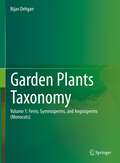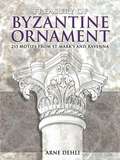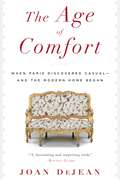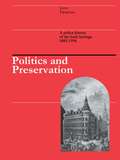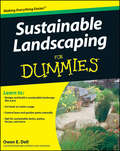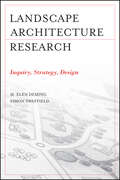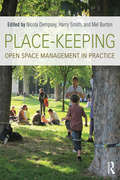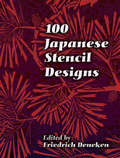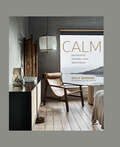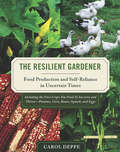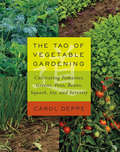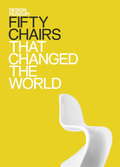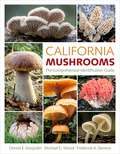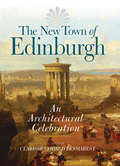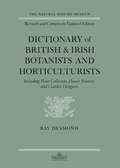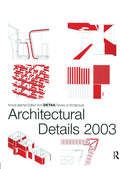- Table View
- List View
Garden Plants Taxonomy: Volume 1: Ferns, Gymnosperms, and Angiosperms (Monocots)
by Bijan DehganHorticulture has remained far behind in understanding of botanical principles. Recent phylogenetic (DNA-based) reorganization of higher plants has revolutionized taxonomic treatments of all biological entities, even when morphology does not completely agree with their organization. This book is an example of applying principals of botanical phylogenetic taxonomy to assemble genera, species, and cultivars of 200 vascular plant families of ferns, gymnosperms, and angiosperms that are cultivated for enhancement of human living space; homes, gardens, and parks. The emphases are on cultivated species but examples of some plants are often shown in the wild and in landscapes. In providing descriptions, it is assumed that students and other interested individuals have no background in general botany (plant characteristics), or nomenclature. Fundamental features of all plant groups discussed are fully illustrated by original watercolor drawings or photographs. Discussion of the families is grounded on recent botanical phylogenetic treatments, which is based on common ancestry (monophyly). Of course, phylogenetic taxonomy is not a new concept, and was originally based on morphological characteristics; it is the DNA-based phylogeny that has revolutionized modern biological classifications. In practical terms, this book represents the horticultural treatment that corresponds to phylogenetic-based botanical taxonomy, to which is added cultigens and cultivated genera and species. Hence, the harmony between horticultural and botanical taxonomy. This book covers phylogenetic-based taxonomy of Ferns, Gymnosperms, and Angiosperms (Monocots). A companion volume covers Angiosperms (Eudicots).
Treasury of Byzantine Ornament: 255 Motifs from St. Mark's and Ravenna
by Arne DehliThe art of the Eastern Roman Empire and of its capital, Byzantium (Constantinople), found expression throughout the ancient world, particularly in Italian architecture. This superb archive of Byzantine ornament contains a wealth of decorative architectural elements derived from sixth- and seventh-century Italian buildings in Ravenna and in the Venetian church of St. Mark's.Depicted in more than 250 delicate line drawings are splendid perforated marble panels, intricately fashioned stone grilles and cornices, lavish candle brackets, elaborate stone mosaics for floors and ceilings, bronze window guards, as well as an abundance of decorative wreaths, rosettes, mouldings, and medallions.A multipurpose reference for students, artists, and designers, this archive of sumptuous, royalty-free designs will also serve as a rich source of inspiration for anyone working in the fine or applied arts.
The Age of Comfort: When Paris Discovered Casual--and the Modern Home Began
by Joan DeJeanToday, it is difficult to imagine a living room without a sofa. When the first sofas on record were delivered in seventeenth-century France, the result was a radical reinvention of interior space. Symptomatic of a new age of casualness and comfort, the sofa ushered in an era known as the golden age of conversation; as the first piece of furniture designed for two, it was also considered an invitation to seduction. With the sofa came many other changes in interior space we now take for granted: private bedrooms, bathrooms, and the original living rooms. None of this could have happened without a colorful cast of visionaries-legendary architects, the first interior designers, and the women who shaped the tastes of two successive kings of France: Louis XIV's mistress Madame de Maintenon and Louis XV's mistress Madame de Pompadour. Their revolutionary ideas would have a direct influence on realms outside the home, from clothing to literature and gender relations, changing the way people lived and related to one another for the foreseeable future.
Politics and Preservation: A policy history of the built heritage 1882-1996 (Planning, History and Environment Series #Vol. 22)
by John Delafons J. DelafonsThis book traces the policy history of urban conservation and its relationship to the town planning process and both are set in their political context. Part One deals with the origins of conservation and its cultural background. Part Two deals with the post-war legislation and the increasing scope of conservation. Part Three deals with churches and their separate control system, and Part Four brings the story up to the present time. New issues such as sustainable conservation and the latest government policy are addressed in the conclusion. This book will aid current practice and help to inform future directions.
Politics and Preservation: A policy history of the built heritage 1882-1996 (Planning, History and Environment Series)
by John Delafons J. DelafonsThis book traces the policy history of urban conservation and its relationship to the town planning process and both are set in their political context. Part One deals with the origins of conservation and its cultural background. Part Two deals with the post-war legislation and the increasing scope of conservation. Part Three deals with churches and their separate control system, and Part Four brings the story up to the present time. New issues such as sustainable conservation and the latest government policy are addressed in the conclusion. This book will aid current practice and help to inform future directions.
Engineering for Cats: Better the Life of Your Pet with10 Cat-Approved Projects
by Mac DelaneyLearn how to construct a fancy cat water fountain, cat shelves, and more, in this whimsical but practical guide. Aerospace engineer Mac Delaney leads readers through 10 projects that solve everyday cat-people problems, complete with step-by-step illustrations.
Sustainable Landscaping For Dummies: [*develop A Profitable Business Plan *build Word-of-mouth Referrals *handle Employees, Paperwork, And Taxes *work Smart And Safe *adapt To New Trends Like Sustainable Landscaping *become Your Area's Top Landscaper (Globe Pequot Ser.)
by Owen E. DellSustainable Landscaping For Dummies provides hands-on, how-to instruction for realizing the benefits of a sustainable landscape, from selecting sutainable hardscape materials to installing a rain-water catchment system to choosing native plants.
Sustainable Landscaping For Dummies
by Owen E. DellSustainable Landscaping For Dummies provides hands-on, how-to instruction for realizing the benefits of a sustainable landscape, from selecting sutainable hardscape materials to installing a rain-water catchment system to choosing native plants.
Landscape Architectural Research: Inquiry, Strategy, Design
by M. Elen Deming Simon SwaffieldA practical, single-source guide tosuccessful strategies for landscape architecture research As the scope of landscape architecture expands to engage with other disciplines, and streams of information directing this field continue to grow and diversify, it becomes increasingly important for landscape architects to be able to implement a range of effective research strategies when seeking, creating, and validating knowledge. Landscape Architecture Research offers a framework for advancing better design thinking solutions by supplying readers with a system of inquiry tactics that open up a wider range of research possibilities. With a logical and innovative approach that favors legitimacy of knowledge based on collective, grounded practices, rather than strict adherence to protocols drawn only from scientific models, this comprehensive, illustrated guide produces a sound argument for establishing a new paradigm for legitimizing research quality. Landscape Architecture Research presents: Case studies that show how the range of presented research strategies have been successfully used in practice New perspective on the relationship between theory, research, practice, and critique, a relationship that is specific to landscape architecture Detailed coverage of the ways that new knowledge is produced through research activities and practical innovations in landscape architecture The first and only book on this topic of growing importance in landscape architecture, Landscape Architecture Research keeps professionals and students in step with the latest developments in landscape architecture, and delivers a dynamic and flexible game plan for verifying the integrity of their work.
Landscape Architectural Research: Inquiry, Strategy, Design
by M. Elen Deming Simon SwaffieldA practical, single-source guide tosuccessful strategies for landscape architecture research As the scope of landscape architecture expands to engage with other disciplines, and streams of information directing this field continue to grow and diversify, it becomes increasingly important for landscape architects to be able to implement a range of effective research strategies when seeking, creating, and validating knowledge. Landscape Architecture Research offers a framework for advancing better design thinking solutions by supplying readers with a system of inquiry tactics that open up a wider range of research possibilities. With a logical and innovative approach that favors legitimacy of knowledge based on collective, grounded practices, rather than strict adherence to protocols drawn only from scientific models, this comprehensive, illustrated guide produces a sound argument for establishing a new paradigm for legitimizing research quality. Landscape Architecture Research presents: Case studies that show how the range of presented research strategies have been successfully used in practice New perspective on the relationship between theory, research, practice, and critique, a relationship that is specific to landscape architecture Detailed coverage of the ways that new knowledge is produced through research activities and practical innovations in landscape architecture The first and only book on this topic of growing importance in landscape architecture, Landscape Architecture Research keeps professionals and students in step with the latest developments in landscape architecture, and delivers a dynamic and flexible game plan for verifying the integrity of their work.
Place-Keeping: Open Space Management in Practice
by Nicola Dempsey Harry Smith Mel BurtonPlace-Keeping presents the latest research and practice on place-keeping – that is, the long-term management of public and private open spaces – from around Europe and the rest of the world. There has long been a focus in urban landscape planning and urban design on the creation of high-quality public spaces, or place-making. This is supported by a growing body of research which shows how high-quality public spaces are economically and socially beneficial for local communities and contribute positively to residents’ quality of life and wellbeing. However, while large amounts of capital are spent on the creation of open spaces, little thought is given to, and insufficient resources made available for, the long-term maintenance and management of public spaces, or place-keeping. Without place-keeping, public spaces can fall into a downward spiral of disrepair where anti-social behaviour can emerge and residents may feel unsafe and choose to use other spaces. The economic and social costs of restoring such spaces can therefore be considerable where place-keeping does not occur. Place-Keeping also provides an accessible presentation of the outputs of a major European Union-funded project MP4: Making Places Profitable, Public and Private Open Spaces which further extends the knowledge and debate on long-term management of public and private spaces. It will be an invaluable resource for students, academics and practitioners seeking critical but practical guidance on the long-term management of public and private spaces in a range of contexts.
Place-Keeping: Open Space Management in Practice
by Nicola Dempsey Harry Smith Mel BurtonPlace-Keeping presents the latest research and practice on place-keeping – that is, the long-term management of public and private open spaces – from around Europe and the rest of the world. There has long been a focus in urban landscape planning and urban design on the creation of high-quality public spaces, or place-making. This is supported by a growing body of research which shows how high-quality public spaces are economically and socially beneficial for local communities and contribute positively to residents’ quality of life and wellbeing. However, while large amounts of capital are spent on the creation of open spaces, little thought is given to, and insufficient resources made available for, the long-term maintenance and management of public spaces, or place-keeping. Without place-keeping, public spaces can fall into a downward spiral of disrepair where anti-social behaviour can emerge and residents may feel unsafe and choose to use other spaces. The economic and social costs of restoring such spaces can therefore be considerable where place-keeping does not occur. Place-Keeping also provides an accessible presentation of the outputs of a major European Union-funded project MP4: Making Places Profitable, Public and Private Open Spaces which further extends the knowledge and debate on long-term management of public and private spaces. It will be an invaluable resource for students, academics and practitioners seeking critical but practical guidance on the long-term management of public and private spaces in a range of contexts.
100 Japanese Stencil Designs (Dover Pictorial Archive)
by Friedrich DenekenThe natural Japanese affinity for decorative art is apparent in this striking collection of exquisite stencil designs. A centuries-old tradition of capturing nature in striking floral and wildlife motifs is reflected in the graceful shapes and lovely lines of more than 100 illustrations. Lush blossoms, bamboo branches, butterflies, birds on the wing, and rustic country homes, among other subjects long associated with Japanese art, are boldly printed in black and white.Ready for use as patterns for wallpaper, textiles, graphics, and needlework, these delicate royalty-free images are ideal for a host of modern decorative and graphic needs.
Calm
by Sally DenningIn recent times, many of us have spent more time at home than ever before. Creating a home that instills a sense of calm will cocoon and protect us from the outside world, create a sense of wellbeing and make us feel truly nurtured. Calm will help you create a restful, restorative interior that draws you in and makes your shoulders drop the moment you walk through the door. Sally Denning first explores the essential foundations of a tranquil, comforting home: calming and harmonious colours, textiles, pattern, lighting and decorative elements. She goes on to explore a mix of accessible real-life homes, ranging from city homes to country houses, new builds, flats/apartments, beach houses and more. The spaces may be different, but they all share one thing: a timeless, soothing and restful atmosphere that is a pleasure to come home to.
The Resilient Gardener: Food Production and Self-Reliance in Uncertain Times
by Carol DeppeScientist/gardener Carol Deppe combines her passion for organic gardening with newly emerging scientific information from many fields — resilience science, climatology, climate change, ecology, anthropology, paleontology, sustainable agriculture, nutrition, health, and medicine. In the last half of The Resilient Gardener, Deppe extends and illustrates these principles with detailed information about growing and using five key crops: potatoes, corn, beans, squash, and eggs. In this book you’ll learn how to: •Garden in an era of unpredictable weather and climate change •Grow, store, and use more of your own staple crops •Garden efficiently and comfortably (even if you have a bad back) •Grow, store, and cook different varieties of potatoes and save your own potato seed •Grow the right varieties of corn to make your own gourmet-quality fast-cooking polenta, cornbread, parched corn, corn cakes, pancakes and even savory corn gravy •Make whole-grain, corn-based breads and cakes using the author’s original gluten-free recipes involving no other grains, artificial binders, or dairy products •Grow and use popbeans and other grain legumes •Grow, store, and use summer, winter, and drying squash •Keep a home laying flock of ducks or chickens; integrate them with your gardening, and grow most of their feed. The Resilient Gardener is both a conceptual and a hands-on organic gardening book, and is suitable for vegetable gardeners at all levels of experience. Resilience here is broadly conceived and encompasses a full range of problems, from personal hard times such as injuries, family crises, financial problems, health problems, and special dietary needs (gluten intolerance, food allergies, carbohydrate sensitivity, and a need for weight control) to serious regional and global disasters and climate change. It is a supremely optimistic as well as realistic book about how resilient gardeners and their vegetable gardens can flourish even in challenging times and help their communities to survive and thrive through everything that comes their way — from tomorrow through the next thousand years. Organic gardening, vegetable gardening, self-sufficiency, subsistence gardening, gluten-free living.
The Tao of Vegetable Gardening: Cultivating Tomatoes, Greens, Peas, Beans, Squash, Joy, and Serenity
by Carol DeppeThe Tao of Vegetable Gardening explores the practical methods as well as the deeper essence of gardening. In her latest book, groundbreaking garden writer Carol Deppe (The Resilient Gardener, Breed Your Own Vegetable Varieties) focuses on some of the most popular home garden vegetables—tomatoes, green beans, peas, and leafy greens—and through them illustrates the key principles and practices that gardeners need to know to successfully plant and grow just about any food crop. Deppe’s work has long been inspired and informed by the philosophy and wisdom of Tao Te Ching, the 2,500-year-old work attributed to Chinese sage Lao Tzu and the most translated book in the world after the Bible. The Tao of Vegetable Gardening is organized into chapters that echo fundamental Taoist concepts: Balance, Flexibility, Honoring the Essential Nature (your own and that of your plants), Effortless Effort, Non-Doing, and even Non-Knowing. Yet the book also offers a wealth of specific and valuable garden advice on topics as diverse as: • The Eat-All Greens Garden, a labor- and space-efficient way to provide all the greens a family can eat, freeze, and dry—all on a tiny piece of land suitable for small-scale and urban gardeners. • The growing problem of late blight and the future of heirloom tomatoes—and what gardeners can do to avoid problems, and even create new resistant varieties. • Establishing a Do-It-Yourself Seed Bank, including information on preparing seeds for long-term storage and how to “dehybridize” hybrids. • Twenty-four good places to not plant a tree, and thirty-seven good reasons for not planting various vegetables. Designed for gardeners of all levels, from beginners to experienced growers, The Tao of Vegetable Gardening provides a unique frame of reference: a window to the world of nature, in the garden and in ourselves.
Fifty Chairs that Changed the World: Design Museum Fifty (Design Museum Fifty)
by Design Museum Enterprise LimitedEverything around us is designed and the word 'design' has become part of our everyday experience. But how much do we know about it? Fifty Chairs That Changed the World imparts that knowledge listing the top 50 chairs that have made a substantial impact in the world of British design today. From Thonet's 1870 Side Chair to Konstantin Grcic's Chair_One, each entry offers a short appraisal to explore what has made their iconic status and the designers that give them a special place in design history.
Landscape Architecture Documentation Standards: Principles, Guidelines, and Best Practices
by Design WorkshopSUPERB EXECUTION RELIES UPON RIGOROUS PROJECT DOCUMENTATION A project will only be built as well as it is documented. This publication focuses on the key documentation needs of the landscape architectural design and construction documentation process. That includes both "design documentation" and "construction documentation" as well as all that which occurs in the transition from one phase to the other. Documentation requirements include those components necessary to explore and define design intent, logic, physical proposals, and ultimately, the specific components included within construction and bid documents. Discover how proper documentation facilitates every stage of the design process from pre-planning to construction, and leads to a highly resolved built outcome. Understand the principles behind these documentation practices. Implement best practices specific to each documentation phase and drawing, from title block and cover sheet design to soil plans and plant protection. Organize keynoting systems, cross-referencing and interdisciplinary coordination amongst multiple consultants and vendors. Study sample project documents from a leading landscape architecture firm to better understand the elements and benefits of complete and well-coordinated project documentation. These standards have been time-tested by over 150 designers at the industry leading landscape architecture firm Design Workshop, reflecting a range of project types, including parks, streetscapes, urban spaces and over-structure construction. This guide shares the methods behind the success, to facilitate exceptional built outcomes through principled documentation practices.
Landscape Architecture Documentation Standards: Principles, Guidelines, and Best Practices
by Design WorkshopSUPERB EXECUTION RELIES UPON RIGOROUS PROJECT DOCUMENTATION A project will only be built as well as it is documented. This publication focuses on the key documentation needs of the landscape architectural design and construction documentation process. That includes both "design documentation" and "construction documentation" as well as all that which occurs in the transition from one phase to the other. Documentation requirements include those components necessary to explore and define design intent, logic, physical proposals, and ultimately, the specific components included within construction and bid documents. Discover how proper documentation facilitates every stage of the design process from pre-planning to construction, and leads to a highly resolved built outcome. Understand the principles behind these documentation practices. Implement best practices specific to each documentation phase and drawing, from title block and cover sheet design to soil plans and plant protection. Organize keynoting systems, cross-referencing and interdisciplinary coordination amongst multiple consultants and vendors. Study sample project documents from a leading landscape architecture firm to better understand the elements and benefits of complete and well-coordinated project documentation. These standards have been time-tested by over 150 designers at the industry leading landscape architecture firm Design Workshop, reflecting a range of project types, including parks, streetscapes, urban spaces and over-structure construction. This guide shares the methods behind the success, to facilitate exceptional built outcomes through principled documentation practices.
California Mushrooms: The Comprehensive Identification Guide
by Dennis E. Desjardin Michael G. Wood Frederick A. StevensCalifornia Mushrooms is a comprehensive guide, providing information on when and where to find mushrooms; guidelines on how to collect and identify mushrooms; keys to species; and overviews of nomenclature and taxonomy, morphology and phylogeny, fungal ecology, biology, and mushroom toxins.
The New Town of Edinburgh: An Architectural Celebration
by Clarisse Godard DesmarestThis collection of innovative essays celebrates the New Town of Edinburgh over the 250 years since its original creation. The contributing authors discuss the intellectual, economic and political contexts which provided the impetus for the city of Edinburgh to expand north of the Old Town, and analyse the New Town’s unique architectural status in terms of its size, monumentality and degree of preservation. For centuries, Scotland has pursued innovation, improvement, commerce and contact with England and the Continent; and since medieval times it has been an urbanising land of planned towns. This book reflects on the constantly changing dialogue between Edinburgh’s Old and New Towns, from the eighteenth century to the present time, as the city became increasingly commercialised. It also compares Edinburgh’s New Town with more recent new towns elsewhere, notably nineteenth-century Dunedin in New Zealand and Scotland’s planned new-town movement of the twentieth century. The age of conservation is another of the central themes.
Dictionary Of British And Irish Botantists And Horticulturalists Including plant collectors, flower painters and garden designers
by Ray DesmondOver the past four centuries botanists and gardeners in the British Isles have gathered, maintained and propagated many varying species of plants. Their work has been documented in innumerable books and articles which are often difficult to trace. The Dictionary of British and Irish Botanists and Horticulturalists represents a time-saving reference source for those who wish to discover more about the lives and achievements of the horticulturalists listed. The dictionary's utility comes not only from indicating the major publications of the named authors, but also the location of their herbaria and manuscripts.; The previous 1977 edition of the Dictionary has for many years been a much used source of information for botanists, botanic artists and archivists. In this revised edition the scope has been expanded to include among its 13,000 entries flower painters in addition to botanical artists over 1400 entries and, for the first time, garden designers.; Finally the Dictionary should have international appeal since so many botanists and gardeners worked on collective plants overseas, in particular in North America and the British Commonwealth.; Each entry gives, wherever possible, details of dates and places of birth and death, educational qualifications, professional posts, honours and awards, publications, location of plant collections, manuscripts, drawings and portraits. Its main function, however, is to provide further biographical references to books and periodicals. Comprehensive classified indices facilitate access by professions and activities, countries, and plant interests.
Dictionary Of British And Irish Botantists And Horticulturalists Including plant collectors, flower painters and garden designers
by Ray DesmondOver the past four centuries botanists and gardeners in the British Isles have gathered, maintained and propagated many varying species of plants. Their work has been documented in innumerable books and articles which are often difficult to trace. The Dictionary of British and Irish Botanists and Horticulturalists represents a time-saving reference source for those who wish to discover more about the lives and achievements of the horticulturalists listed. The dictionary's utility comes not only from indicating the major publications of the named authors, but also the location of their herbaria and manuscripts.; The previous 1977 edition of the Dictionary has for many years been a much used source of information for botanists, botanic artists and archivists. In this revised edition the scope has been expanded to include among its 13,000 entries flower painters in addition to botanical artists over 1400 entries and, for the first time, garden designers.; Finally the Dictionary should have international appeal since so many botanists and gardeners worked on collective plants overseas, in particular in North America and the British Commonwealth.; Each entry gives, wherever possible, details of dates and places of birth and death, educational qualifications, professional posts, honours and awards, publications, location of plant collections, manuscripts, drawings and portraits. Its main function, however, is to provide further biographical references to books and periodicals. Comprehensive classified indices facilitate access by professions and activities, countries, and plant interests.
Architectural Details 2003
by Detail MagazineThis is a compilation of the full year's information, including: the "Discussion" section, where well-known architects and critics as well as specialist authors and architectural historians articulate their views; the "Documentation" section containing an analysis of selected projects, in which buildings from around the world are covered in depth; and the "Technology" section where the specific theme of each issue of the magazine is treated in greater depth. Along with these are illustrations of the high standards that Detail is known for, where all plan drawings are true to scale and have been approved by the architects, planners and engineers responsible for the original design.This annual sourcebook is a beautiful record, not only of the year's Detail publication, but of some of the best, and most innovative contemporary architecture
Architectural Details 2003
by Detail MagazineThis is a compilation of the full year's information, including: the "Discussion" section, where well-known architects and critics as well as specialist authors and architectural historians articulate their views; the "Documentation" section containing an analysis of selected projects, in which buildings from around the world are covered in depth; and the "Technology" section where the specific theme of each issue of the magazine is treated in greater depth. Along with these are illustrations of the high standards that Detail is known for, where all plan drawings are true to scale and have been approved by the architects, planners and engineers responsible for the original design.This annual sourcebook is a beautiful record, not only of the year's Detail publication, but of some of the best, and most innovative contemporary architecture
